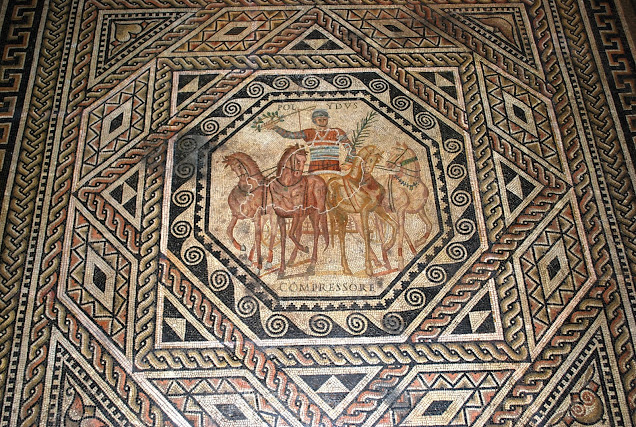A gladiator north of the limes
Today I visited the regional museum 'Huis van Hilde' in Castricum, a small town north of Velsen or Roman Flevum. It was one of the large military settlements or castra, the Romans built along the northern border of their Empire, the Rhine River, to defend themselves against invaders and to prepare for conquests with several legions, in this case fleet expeditions to the Wadden Sea, Ems and Elbe and the invasion of England. There was a harbour where several warships could dock. Unlike most smaller forts, this army camp was built north of the river.
Both Ptolemy, who refers to "Phleum," and Tacitus mention this fortress, but its exact location has long remained a subject of speculation. In the 1980s however, a small Roman castellum was excavated near Velsen, which, according to coin finds and radiocarbon dating, must have been destroyed in the year 28. It is assumed that this was the castellum Flevum.
The fortress played an important role in the Frisii uprising in 28 AD. This uprising is described in the fourth book of Tacitus' Annals. Since the conquests of General Drusus, the Frisii had been liable to pay taxes to the Romans and paid in the form of cattle hides. The Romans used the leather to make their shields. The camp at Velsen became the centre of Roman authority in the region. When a new Roman commander, Olennius, drastically raised taxes, the Frisii found themselves in an impossible situation. They were ordered to supply the (larger) hides of aurochs. But aurochs were rare at the time, and their own cows were smaller, much smaller than modern breeds. The Frisii were forced to hand over their women and children as slaves, after which they revolted. After venting their anger on the Roman tax collectors - who were crucified - a Frisian army marched on Olennius's camp. However, Olennius managed to escape in time. He and his troops settled in the castellum Flevum.
The Frisii besieged the castellum. They attempted to scale the fortress with ropes and scaling ladders, but their attempt failed. After a day, they decided to abandon their attack. They then attempted to besiege Flevum with a fleet. Meanwhile, Roman troops were sent as reinforcements. When the Frisii realized this, they withdrew. This ultimately led to the Battle of Baduhenna Forest, in which 900 Romans were killed and another 400 Romans killed each other.
But why a blog post about a damaged oil lamp depicting a childish image of a gladiator? I've seen quite a few oil lamps in European museums, but I still find this one quite special. Not only because it was almost certainly the property of a Roman soldier far from home, who used it to see in the dark, but also because it was found near a roman watchtower even north of Flevum - near the current city of Krommenie -, being the most northerly Roman military settlement on the European mainland.
The watchtower is square and measured approximately three by three meters at its base. The upper floors were likely slightly larger. Archaeologists uncovered and excavated two of the four corner posts. A large tree-trunk enclosure, a palisade, encompassed the watchtower, enclosing nearly half a football field. According to the researchers, this is unusually large for a palisade around a watchtower. They were usually smaller. The enclosure is not square, as was the case in many other places in Europe, but pentagonal.
(Photo credits of the above picture: municipality Zaanstad)
A quote from the archaeologist of the municipality of Zaanstad in 2018: "The Romans carefully constructed the watchtower and enclosure. The tower stands in a peat bog, and to reach it, they dug out an overgrown creek, creating a canal that connected to waterways leading to civilization. They raised the ground itself with clay sods. The tree trunks were likely brought in from the dunes or from the river area along the Rhine. Construction must have taken a great deal of effort."





